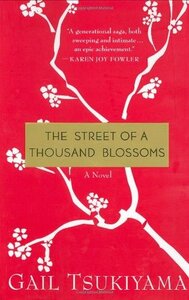Take a photo of a barcode or cover
challenging
emotional
informative
reflective
tense
slow-paced
Plot or Character Driven:
Character
Strong character development:
Complicated
Loveable characters:
Complicated
Diverse cast of characters:
Complicated
Flaws of characters a main focus:
No
Really informative about Noh and Sumo, I learned a lot about both art forms as well as the kasutori culture that emerged after the war.
I found that there were too many characters each given their own story lines. It made the first part of the book pretty confusing and hard to follow. Once all the characters came together it was a lot easier to follow and more enjoyable.
I found that there were too many characters each given their own story lines. It made the first part of the book pretty confusing and hard to follow. Once all the characters came together it was a lot easier to follow and more enjoyable.
Graphic: Genocide, Infertility, Miscarriage, Suicide, Violence, War
medium-paced
Hundreds of graceful vignettes paint vivid pictures of revealing scenes in a number of lives.
A really excellent example of a type of book I generally don't care for, following multiple characters across multiple decades with nary a mystery in sight.
A really excellent example of a type of book I generally don't care for, following multiple characters across multiple decades with nary a mystery in sight.
I picked this book up from my public library because it had a blurb by Michael Chabon. Usually, I don't do that, but I thought, I love his work, maybe I'll love this too. The novel follows the lives of two brothers who are orphans and live with their grandparents. It starts before world war II in Japan and progresses through the mid-sixties. One of the brothers is interested in sumo and becoming a wrestler, while the other brother's interest lies in creating Noh masks for the theatre. The beginning of the book is quite promising and I was immediately drawn in. However, it quickly became overloaded in too many characters and flat scenes. When I think of other novles that have an abundance of characters and work well, I wonder how that is possible? Part of it is that they have their own story, or their story is so tied up in the overall main story. For instance the story might be about an event, instead of a person's life. It didn't work well in this novel. I found myself skimming for the few lines of dialogue that mattered to the brothers' lives. While the writing is beautiful at times, it is not beautiful enough to keep one enthralled. There are writers who can have page after page in which almost nothing happens and it is a gift. Again, that's not the case in this novel. When it comes down to it, this novel can be summed up as a "sports story", and what always happens? The homerun is hit, the touchdown is scored, all the bowling pins get knocked over. Predictable, wandering and flat at times. This one took effort to get through. I might still check out one of her earlier novels, but we'll see.
challenging
emotional
reflective
sad
slow-paced
Plot or Character Driven:
Character
((I DNF, stopped at 36%))
WWII Japanese perspective
A story trailing two orphaned brothers, raised by their grandparents, one pursuing a career in Sumo and the other in creating theater masks.
I would recommend this to historical fiction lovers. I just was not super invested in the characters at 5 hours into the audio book and so I decided to put it down. I might revisit at a later time. I might not.
TW: war, stillbirth, grief, war
WWII Japanese perspective
A story trailing two orphaned brothers, raised by their grandparents, one pursuing a career in Sumo and the other in creating theater masks.
I would recommend this to historical fiction lovers. I just was not super invested in the characters at 5 hours into the audio book and so I decided to put it down. I might revisit at a later time. I might not.
TW: war, stillbirth, grief, war
adventurous
dark
emotional
informative
inspiring
reflective
sad
medium-paced
Plot or Character Driven:
A mix
Strong character development:
Yes
Loveable characters:
Yes
I found this book in a 100 year old rural Japanese house and read it among other books of Japanese authors during my stay.. it answered many questions about Japanese culture from before World War II and how japan changed during the occupation and after. It does not only address foods and social etiquette but also has a heavy focus on Sumo Wrestling Tradition and Mask Making for the Noh Theatre. It leaves you with a bitter aftertaste of how life can slip through your fingers when honor is the main focus of your doings.. I love how intensive Japanese people are, how they keep to themselves which makes small gestures great, and yet I can’t shake off the sadness and yearning that comes with realizing that the time spent waiting for the right moment to really love your loved ones, can be taken away from you at an instant. It really touched upon my constant need to “have funerals for people who are still alive” that I desperately lived by this past decade and now trying to find the balance with more intention… it’s hard to describe. It makes me sad to read of time swiftly passing by people who are waiting to live with the entirety of their being. While simultaneously I admire how much everyone has their own life following their own virtue… it’s a good read.
Graphic: Addiction, Adult/minor relationship, Alcoholism, Animal cruelty, Child death, Death, Gore, Infertility, Infidelity, Mental illness, Miscarriage, Panic attacks/disorders, Physical abuse, Self harm, Suicidal thoughts, Suicide, Violence, Blood, Vomit, Dementia, Grief, Medical trauma, Car accident, Suicide attempt, Death of parent, Pregnancy, Abandonment, Alcohol, Colonisation, War, Injury/Injury detail
I fell into a book hangover after reading Everything is Tuberculosis and the super slow pace of this book couldn’t hold my attention
I love Gail Tsukiyama's peaceful tone. She does a fabulous job of depicting life in Japan, spanning from the pre-World War II era through to the post-War revival. The characters in this story are wonderful, engaging, and alive. Her descriptions are so real; during the most intense moments of the war, I had to stop to catch my breath because I was so emotionally engaged in the story. I sped through this 420-page book and loved every minute of it.
Tsukiyama's writing style is so straightforward, and almost understated in its unique fashion - yet through it she brings her settings come intensely vividly to life, and shapes and narrates the lives characters that are so complex, so developed and almost graphically human. It's not merely impressive - in fact, I don't hesitate to call it astounding.
This book is a episodic look at two brothers during a tumultuous time in Japanese history. They start as orphans, raised by loving grandparents, with the backdrop of a Japan at war with China in 1939. It goes on to show civilian hardships as World War II escalates, the fire bombing of Tokyo, occupation, and a nation rebuilding. The novel has many of the characters close to the boys, Hiroshi and Kenji, as being somewhat pacifist, or at least unenthusiastic about the war, so the hardships they experience draw out a lot of pathos.
The chapters are often fairly short vignettes of the characters' lives, with triumphs and tragedies. My book club co-host compared it aptly to postcards.
Read for the Cincinnati Art Museum "See the Story" program meeting on July 20, 2019. Many people seemed to enjoy it, so that was a success, and we had 20 people show up!
The chapters are often fairly short vignettes of the characters' lives, with triumphs and tragedies. My book club co-host compared it aptly to postcards.
Read for the Cincinnati Art Museum "See the Story" program meeting on July 20, 2019. Many people seemed to enjoy it, so that was a success, and we had 20 people show up!





